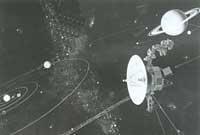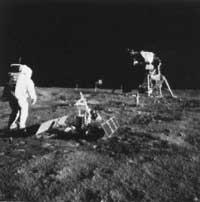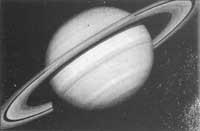The small is beautiful
1992/11/01 Irazabalbeitia, Inaki - kimikaria eta zientzia-dibulgatzaileaElhuyar Fundazioa Iturria: Elhuyar aldizkaria
The scientific community that explores space around the world will soon have to face small budgets and the choice of priorities. Governments have no money and tax payers are not as generous as in the past to the needs of space exploration. All those who learn how to work with less resources than expected will have to get used to it. To make the most of the few existing resources, scientists must work with all their creativity.
Since we began to explore the solar system in the early 1960s, the world has changed a lot. The Cold War and the challenge between states have disappeared and the endless funds of governments have gone to the well. Therefore, to think that in the coming years money will be made to undertake a great planetary mission is far from reality. In addition, missions and projects already approved can be suspended, as demonstrated by the fact that the CRAF mission (Comet Rendezvous Asteroid Flyby = Visit with rendezvous kites and asteroids) is not driven by the US.

If the world scientific community wants to continue exploring the planets, it must adapt to the new situation and raise smaller, cheaper missions.
Cost of cost
If something has driven towards small missions, the cost has undoubtedly been. Adjectives such as payable, cheap, cost-effective are frequently being used in the definition of new missions.
For a mission to the planets to have a “low cost” label, it has to cost about hundreds of millions of dollars. The cost of large missions to date has been at least one billion dollars.
For example, NASA begins to consider two types of low-cost missions: Discovery (Discovery) and Intermediate (Medium). First class missions should not last longer than three years and their cost is less than $150 million. Those of the Intermediate class are bigger and have a cost of approximately $400 million.
Deadlines deadlines deadlines
The main missions and projects carried out to date have required one or more decades for their development and execution. The missions Viking, Voyager or Galileo are the best examples. These types of projects have great results and scientists can survive with one of these, although in the end for some it is boring.
However, the environment has changed and long-term projects are not fashionable. People, politicians, and scientists prefer short-term ones. An example of this is the forecast for a period of between three and five years to finalize the US return project to the moon.
These time limits mark how far we can go. Launchers, propulsion systems, and the most appropriate routes limit missions. If it reaches the Moon in a few days, to reach Artizar and nearby asteroids it takes a few months; to reach Mars it takes a year and a few years to go to Jupiter and Mercury. This type of objectives can be considered from three to five years, but all the planets beyond Saturn are excluded.
Science of science
Small missions do not necessarily create a great science, but if designed and configured well they can have similar results. In fact, among the scientists there are some defenders of small missions. A small mission designed specifically, with the latest technology, can offer incredible results. Two good examples of this are the IRAS (Infrared Astronomy Satellite = Infrared Astronomical Satellite) and the COBE (Cosmic Background Explorer = Cosmic Background Explorer), which has now become so famous.
To carry out a mission with concrete objectives and a limited number of tools, only a small group of trained scientists is necessary. For the collection, treatment and analysis of the resulting data, a limited group of scientists and technicians directed by a good scientist is sufficient. The same group, in addition, can design, build and test tools, in addition to assuming coordination with external elements, with the government and with supply companies, avoiding boring bureaucracies.
Technology technology technology technology
From the outside, there are those who might think that raising small missions is a technological setback that has allowed us to return to the origins of space exploration. It was wrong. The difference between the missions of then and those of now is evident: technology. Thanks to the current electronics and computer technology, in the 1960s it is possible to manufacture with light and small equipment what the great equipment and weight did. In addition, the propulsion and navigation equipment have improved considerably.
Smallness and economicity have other advantages. In fact, they facilitate the use of the latest technology in the field of a rather conservative spatial technology.
Others
On the other hand, it is evident that the small missions, on the one hand, promote the deepening of cooperation and, on the other, seem contradictory, also diversification and competition, since the lower costs of the missions allow more associations or entities to participate in the exploration of the space.
So far space exploration has been driven by great and brilliant missions, but that is a past that has brought us here and we have to look forward, to see where this new path takes us.
Adapted to different articles of the magazine THE PLANETARY REPORT of July/August 1992.
To the moon, faster, cheaper and betterApollo the boats were illuminated for the last time twenty years ago. Since then, apart from the efforts of some Soviet probes, the barrier of the exploration of the moon has been closed. The DAP aims to reinforce this exploration by developing a low, fast and economical labeled scheme. Three missions per automatic probe are expected. In the first one it is a question of studying the chemistry and mineralogy of the terrestrial surface through a satellite of polar orbit. In the second, an orbital probe will also be used, which will study the complex magnetic field of the Moon and an exact surface map will be made. The third previews the ilargirio. The use of two small automatic vehicles is expected and the chemical and mineralogical characteristics of the lunation zone will be studied. The aim of the latter is to find the most suitable places to resurrect man. The cost of each mission ranges from $100 to 150 million and will be completed at three years. |

Gai honi buruzko eduki gehiago
Elhuyarrek garatutako teknologia





